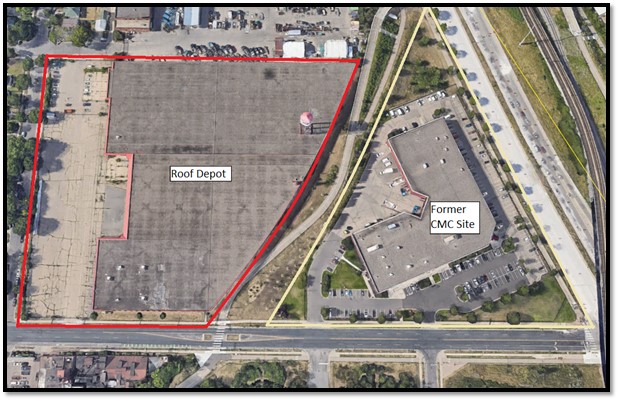Site History
The Roof Depot property located at 1860 East 28th Street, Minneapolis consists of a large warehouse that was constructed in 1947, and a paved parking lot. The city of Minneapolis purchased the property in 2016 with the intention of demolishing the existing warehouse structure and constructing a new City Public Works Facility. The city enrolled the site in the MDA's Agricultural Voluntary Investigation and Cleanup (AgVIC) Program in 2019 due to known arsenic contamination in soil and groundwater at the site.
The Roof Depot property is adjacent to the CMC Heartland Lite Yard Site (CMC site) which is located at 2020 East 28th Street. Arsenic found in the soil under the Roof Depot facility likely originated from the CMC Site, where pesticide manufacturers produced and distributed arsenic-based pesticides between 1938 and 1968.

As part of the city of Minneapolis’ AgVIC investigation, over 80 soil samples were collected from under the Roof Depot building and analyzed for arsenic. Of the samples analyzed, seven exceeded the Minnesota Pollution Control Agency’s arsenic Soil Reference Value (SRV) of 9 milligrams per kilogram (mg/kg). The seven samples exceeding the arsenic SRV are scattered around the site and have concentrations ranging from 15.5 to 174 mg/kg. Additional samples collected below these seven samples did not exceed the SRV. Soil with arsenic concentrations exceeding the SRV are limited to the top four feet of soil.
The MDA has approved three proposed excavations within the Roof Depot building footprint to remove arsenic contaminated soil when the building and/or pavement are removed. These excavations would occur to depths of 2-5 feet below ground surface. The MDA estimates that approximately 4,000 cubic yards of arsenic contaminated soil would be removed. After the excavation of these three areas, confirmation samples would be collected from the sidewalls and bases of the excavations to ensure that soil with arsenic concentrations exceeding the SRV is removed. Clean backfill would be used to bring the excavation to grade. Arsenic-contaminated soil would be disposed of at the SKB Environmental Landfill in Rosemount, Minnesota, a permitted industrial waste landfill.
During excavation activities, several dust suppression methods would be used to minimize the generation and dispersion of dust. Contaminated soil would not be disturbed until the demolition of the building and other hardscapes are removed. If excavation does not occur immediately after building materials are removed, clean fill would be placed over contaminated soil. Excavation work would be completed in phases to minimize the amount of soil exposed at any given time. Excavated areas and exposed soils would be misted with water to curb the creation of dust. MDA staff would visit the site during the arsenic-contaminated soil excavation to ensure the process proceeds according to the MDA approved Response Action Plan. The MDA does not have regulatory authority over the demolition of the Roof Depot building; however, dust suppression methods would be used during the demolition of the building. Dust generated during building demolition is not expected to contain arsenic.
Groundwater below the Roof Depot site is contaminated with arsenic that originated from the CMC Site. Three temporary monitoring wells were installed at the Roof Depot site. The concentrations of arsenic in groundwater samples collected from these wells ranged from 29 micrograms per liter (ug/L) to 805 ug/L. The United States Environmental Protection Agency has set 10 ug/L as the Maximum Contaminant Level for arsenic in community water systems. The city of Minneapolis obtains its water from the Mississippi River; therefore, arsenic contaminated groundwater under the Roof Depot site does not impact the city’s drinking water supply.
In 2005, the MDH established a Special Well Construction Area (SWCA) for the adjacent CMC Site and surrounding area. The SWCA requires MDH review of all wells proposed to be installed within the SWCA. Water supply wells will not be approved for completion in the unconsolidated deposits or the Platteville or St. Peter formations. Special construction and/or monitoring requirements may be imposed by the MDH for wells, in addition to other restrictions. The SWCA includes the area bounded by East 26th Street on the north, 26th Avenue on the east, Lake Street on the south, and Bloomington Avenue South on the west, within the City of Minneapolis.
After remediation of the CMC Site, the Minnesota Department of Health (MDH) conducted a study which analyzed arsenic concentrations found in urine in children living near the CMC Site. Based on the MDH Minneapolis Children’s Arsenic Study, there was not a relationship between the soil arsenic concentrations found in residential soil and arsenic concentrations in urine in children tested. While no relationship was found, the absence of a correlation between arsenic urine levels and soil arsenic levels in the study does not suggest an absence of risk from soil contamination. The study recommended following public health policies that minimize exposure risks to residents, including continued remediation and prevention of soil ingestion.
For more information and to request a copy of the report please contact:
Minnesota Department of Health
Minnesota Tracking and Biomonitoring Program
651-201-5662
health.biomonitoring@state.mn.us
MN Biomonitoring Past Project
Reference: Minnesota Department of Health. (2009). Minneapolis Children's Arsenic Study: A Biomonitoring Pilot Project.
Health Questions
Please contact the Minnesota Department of Health staff listed below with any questions related to health.
Daniel Pena
Health Assessor
651-201-4920
Arsenic Contamination Questions
Please contact the MDA staff listed under "Contact Us".

